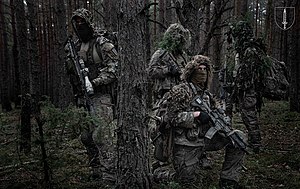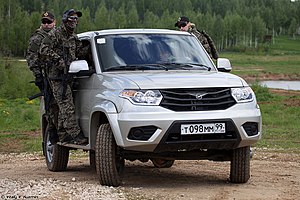Kiravian Armed Forces
This page is currently undergoing major reconstruction in accordance with broader lore changes. |
| Federal Armed Forces | |
|---|---|
| Rektārkax Irthuderix Hérsan | |
 Emblem of the Kiravian Forces | |
| Founded | 1607 AD |
| Current form | 1935 AD |
| Service branches | |
| Headquarters | The Citadel, Kartika |
| Leadership | |
| Commander-in-chief | Adheritus Ilkashvar |
| Ch. Defence Executive | Epavran Xesparav |
| Supreme General | Sendar Vódlin |
| Manpower | |
| Military age | 17-40 |
| Conscription | Suspended since 1988 AD |
| Active personnel | 10,268,359 (8.9‰) |
| Reserve personnel | 5,337,607 (4.65‰) |
| Expenditures | |
| Budget | ₮3.497 trillion |
| Percent of GDP | 6.68% |
| Industry | |
| Domestic suppliers | Kiro-Fiannrian Armenwerke Vrixur Aircraft Works Tredagon Arms Foundry Larserion Systems SAK |
| Foreign suppliers | |
The Kiravian Armed Forces are the military forces of the Kiravian Federacy.
History
The history of the Kiravian Armed Forces begins with the formation of the Kiravian Navy by the Kiravian Confederation. It was agreed that a single navy financed jointly by the states to protect the Confederation's coasts, commercial interests, and growing overseas settlements would be more effective than the existing naval forces maintained by individual coastal states.
The Confederation had no standing army. Small units of professional soldiers were maintained full time under the authority of individual states and at their expense; full-fledged armies were raised by each state when needed. The states were obligated to provide armies to the Confederation in wartime, which would serve under the command of grandees appointed by the Confederal Stanora.
A truly national army was first organised for fight the Continental War, and a standing army under permanent federal command would be established when the new federalist constitution was enacted after the war.
In 1967 AD, during the Sunderance, civilian responsibility for both the Army and the Navy was consolidated under the Defence Executive, with the Cutter Service remaining within the purview of the Maritime Executive.
Following Kiravian Reunification in 1985 AD, the Armed Forces faced the monumental tasks of adapting to a radically different threat environment and absorbing the personnel and assets of the defunct Kiravian People's Army.
In the 2020s AD, the Kiravian Armed Forces were a major participant in the Final War of the Deluge, by far their most extensive mobilisation since the First Great War. Although the Kiravian forces ultimately prevailed over Varshan and would come to occupy the debellated country's eastern third, this victory came at a high cost, exemplified by the prolonged and bloody stagnation of the Kiravian advance during the Battle of the Yaviža Gap. The war exposed many serious weaknesses, mainly in the Army and particularly in its infantry capabilities, raising grave concerns at the highest levels of the military and government.
In 2026 AD the Ilkaśvar administration undertook comprehensive reforms to modernise the Armed Forces. These reforms included the reorganisation of the Army Air Corps as a service branch in its own right, the Kiravian Air Force.
Organisation
Command Structure
Apex Command Authority
The Prime Executive of the Kiravian Federacy is the ultimate command authority and commander-in-chief of the Kiravian Forces, as stipulated by the Fundamental Statute. In the modern era, the Prime Executive exercises his command authority in consultation with two overlapping bodies: Kiravian High Command, which comprises the general staff of the Armed Forces; and the Strategon, which comprises the senior members of the High Command as well as the cabinet Executives and agency heads with security portfolios, the Prime Executive himself, and a coordinating civilian advisor known as the Polemarch. Administrative responsibility for the military lies with the Chief Defence Executive, who is a member of the Strategon and supervises the High Command. The Chief Defence Executive can issue binding directives to the military (to produce information, take administrative actions, manage personnel, et cetera) but cannot independently give combat orders. However, under current protocols, the Chief Defence Executive is often responsible for relaying and confirming the Prime Executive's orders to military officers. Orders are typically transmitted from the Prime Executive through the Chief Defence Executive to the relevant member of the High Command, who then passes it down to the relevant regional or functional combatant commander, and so forth down the chain of command to field officers for execution. However, the Prime Executive can (and often does) issue orders directly, and orders can be delivered from the civilian authorities to any level of the military command structure while bypassing superior officers if needed.
Kiravian High Command comprises the Field Marshal of the Kiravian Federacy (the highest ranking officer of the Federal Army), the Fararektur (the highest-ranking officer of the Navy, best translated as "Governor of the Seas"), the commanders of each of the regional and functional combatant commands, the High General of the Air Force and High General of the Marine Corps, and (notionally) any officers at or above paygrade O-13. Its chairman holds the rank of Supreme General or Supreme Admiral, with the position alternating every three years between the Field Marshal and the Fararektur.
Service Branches
The Kiravian Armed Forces comprise the Army, Air Force, Navy, a yet-unnamed territorial defence branch, and the Maritime Cutter Service
Army

The Kiravian Army, officially the Federal Army, operates the Federacy's capability for terrestrial warfare. The Federal Army was organised after the final unification of the Kiravian island continent by the Continental War, which left the homeland well-protected by vast ocean distances. As such, the Federal Army's role been mainly expeditionary and colonial for most of its history, the chief exceptions being the Kiravian Civil War and the consequent defencive retrenchment of the Kiravian Remnant.
Since Kiravian reunification, the Army has reverted to its traditional mission profile, chiefly concerned with the security of Kiravian overseas territories and interventions in the regional neighbourhoods thereof, with most of its resources devoted to Crona.
Air Force
The Kiravian Airforce (Asûrhérsan), previously the Kiravian Army Aircorps (Asûrfestin Kiravix Hérsask) is the nation's air, space, and strategic missile force. In the postmodern era, air mobility and aerial superiority are crucial to the Federacy's military strategy. The Kiravian Airforce mission profile includes providing air support (logistical, reconnaisance, and tactical) to the Army's ground operations, patrolling Kiravian airspace, projecting power outward from Kiravian territories into the surrounding seas and nearby continents, and providing the Federacy's capacity for strategic strikes and missile defence.
Keeping with the demands of its mission profile, the Airforce's inventory of combat aircraft is concentrated heavily in long-range bombers and interceptors.[source?]
The Kiravian Navy is a blue-water navy tasked with defending Kiravian holdings and interests at sea. The contemporary Navy's primary concerns are defence of the Kiravian overseas colonies; the protection of Ixnayan and interregional sealanes vital to the Federacy's pluricontinental security, energy supply, and commercial navigation; and the projection of military power in support of Kiravian foreign policy. The Federal Navy relies on an extensive network of island bases and cutting-edge naval aviation and naval artillery to maintain a regionwide presence.
Territorial Defence Forces

The Fundamental Statute preserves the right of the federated states to maintain armed forces for their own defence by virtue of dual sovereignty. Leave to raise defence forces is also extended to non-state provinces (territories, federal districts, etc.) by legislation. Under the Confederate Republics and early Federacy, voluntary contributions of state forces and militia provided the backbone of Kiravian military manpower. Since 2026, the relationship between the federal and provincial armed forces has existed within the framework of the Territorial Defence Act, which established the Territorial Defence Forces as a branch of the Federal Armed Forces responsible for organising and coördinating provincial forces in support of overall national defence goals.
The Territorial Defence forces form the largest component of the Federacy's military reserves (the other components being the Naval Reserve and Army/Airforce Retired Reserve), and play an integral rôle in its homeland defence planning. They are now closely tied to the federal military through financial, training, and equipment transfer arrangements. Whereas the Regular Army and the Army Marine Corps are focused on an expeditionary and colonial mission profile, the provincial forces have taken on primary responsibility for homeland defence readiness, serving to deter aggression against the Federacy's major landmasses and to combat domestic threats.
Provincial forces are regularly deployed in support of federal operations overseas, and are highly valued for their terrain specialties. For example, if fighting in a subarctic environment, the Federal Army would call upon the state troops of Koskenkorva or Saxalin Islands who routinely train in comparable conditions.
Maritime Cutter Service
The Cutter Service is the enforcement and operations agency of the Federal Maritime Executive. In addition to its civilian functions, which include search-and-rescue, marine law enforcement, and navigation safety; the Cutter Service has military and paramilitary roles, and remains a component of the Armed Forces by law. The Cutter Service is involved in coastal defence, maritime surveillence, and defence readiness. It bears primary responsibility for patrolling certain designated waterways, such as the Straits of Ilánova and the Æonara Sound. The Cutter Service trains and plans for combat missions as part of the Federacy's contingency plans for an invasion of Æonara, Great Kirav, or Suderavia, and is actively involved in ensuring the security of New Ardmore.
The official geographic remit of the Cutter Service is limited to the waters surrounding Great Kirav, Æonara, Koskenkorva, Suderavia, and New Ardmore. Beyond these regions, coast guard roles are performed by provincial maritime forces, such as the Sydonan Navy and the consolidated Sarolastan Thematic Navy. A few Mainland states - Fariva, Kaviska, Hanoram, and Province №7 - maintain small naval auxiliaries largely limited to civil defence support roles.
Equipment
Armaments
Gats
- RCA-2009 - Primary infantry rifle
- MDNS «Maktstepân» - Secondary infantry rifle
- FP-2000 - Sniper rifle
- MAG-17 - Primary service pistol
Mortars
- 120 Krh/40
- M103 Shovel Mortar (legacy status in the Regular Army, still actively used by Territorial Defence units)
Field Artillery
Anti-Armour
- MAS-12 - Guided anti-tank missile
Anti-Aircraft
- TAF98 «Trakśa» - Man-portable air-defense system
- ITO05M - Man-portable air-defense system
Psychological warfare
Ground Vehicles
- Potato IFV - Primary infantry fighting vehicle
- Utah Jazz - Self-propelled howitzer (tracked)
- GSW 2433 - Self-propelled howitzer (wheeled)
- System 8
- K239 «Asûrsterliń» - Multiple rocket launcher
- Tivômok APC - Armoured personnel carrier
- Honeybadger MIS - Unmanned ground vehicle
- ŪSA Patriot - Patrol SUV for military policing and domestic deployments.
Installations
| Installation | Service Branch | Locality | Country | Information |
|---|---|---|---|---|
| Joint Base Abuluoha | Abuluoha Atoll | Regional rapid response readiness base; Island garrison | ||
| Apanikeran Military Reservation | Co. Apanikeran | Interservice main training facility for jungle warfare training. | ||
| Camp Blaskoller | Co.Vénerva | Logistical support centre. | ||
| Fort Kenmór | Saint Detrick | |||
| Fort Mérovin | ||||
| Jeb!ultepec Airport | Rizal Jeb! Prefecture | Headquarters of KF military administration in the Varshan | ||
| Kartika Citadel | Arthodun | Headquarters of the Defence Executive and KF High Command | ||
| Katolien Armoury | Estòvestra | Research and development, Communications & Electronics Command | ||
| Kítruva Naval Harbour | Kítruva | |||
| Leonoix Cutter Yard | Co. Koffin | |||
| Mirśamur Naval Harbour | Mirśamur | |||
| Perakan Naval Operations Complex | multiple sites | Odoneru Fleet HQ; includes Eusamur Naval Docks and Fleet Consolidated Prison. | ||
| Porsáilen Airbase | Co. Śevrun | |||
| Rubix Bay Naval Base | ||||
| Scapa Base | ||||
| Camp Uométov | Co. Kásungen |